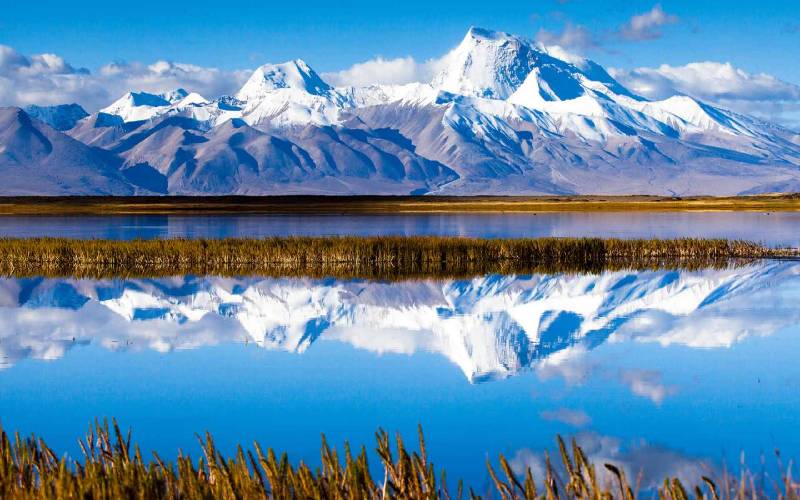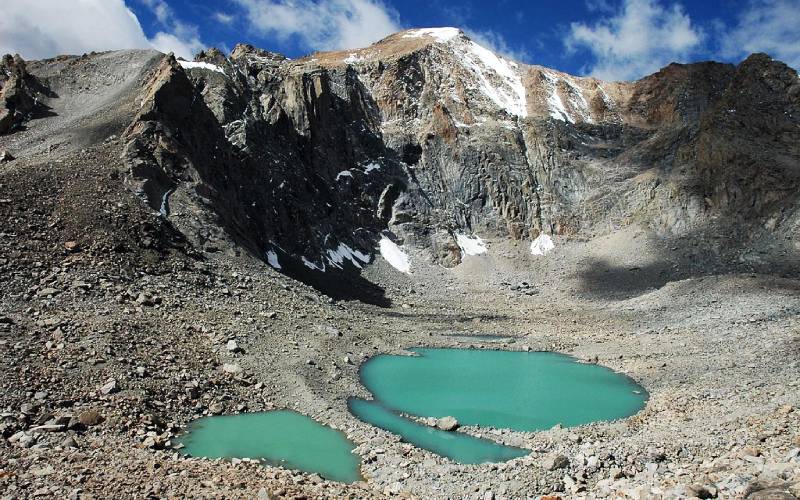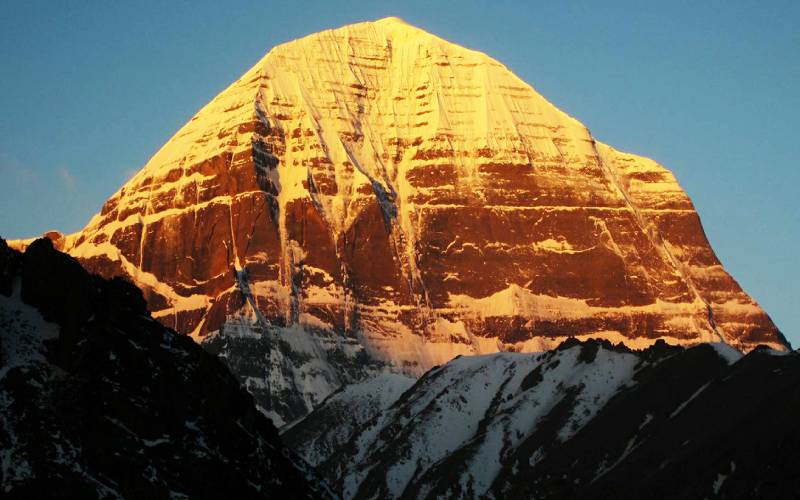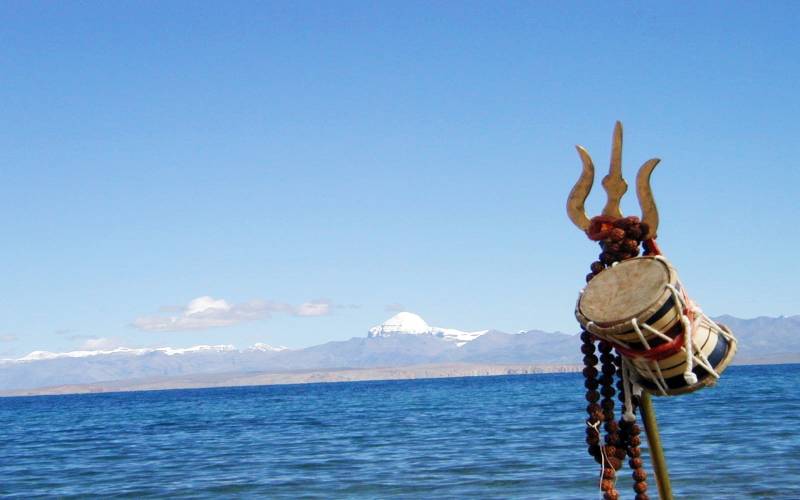
Manasarovar is a large freshwater lake located in Burang County, Ngari Prefecture at Tibet. This lake and the Mount Kailash are sacred to Buddhism, Hinduism, and Jainism. The lake is fed by the Kailash Glaciers. The Sanskrit word, Manasarovar, is a combination of manas meaning, mind, intellect, intelligence, understanding, perception, sense, and conscience, sarovar means a lake or a large pond deep enough for a lotus. This sacred lake is located about 50 kilometres to the northwest of Nepal and 100 kilometres east of Uttarakhand. It is located at an altitude of 4590 meters above sea level in Southwestern Tibet.
Manasarovar is a relatively high elevation freshwater lake on the mostly saline lake studded Tibetan Plateau, and it completely freezes in winter. The lake is almost round in shape and has a circumference of 88 kilometres, while its depth is about 90 meters, the surface area is also quite large. The lake is connected to the nearby Raakshash Sthal lake by the Ganga-Chhu Channel. The sacred lake is near the source of River Sutlej and is the source for rivers, Brahmaputra, Indus, and Karnali (An important tributary of Ganges).
Lake Manasarovar overflows into the famous Raakshash Sthal lake which happens to be an endorheic lake. When the level of Lake Raakshash Sthal and Manasarovar match each other, the combined lake overflows into the Sutlej basin. Raakshash Sthal Lake was created by Ravana for the purpose of garnering superpowers through the acts of devotion to Lord Shiva who resided in Mount Kailash. He used to pray on a separate island within this lake and would make an offering of one of his ten heads at the rate of one per day as a sacrifice to Lord Shiva. Finally, Shiva got moved by his devotion and granted him some special powers. Tibetans refer this as a ghost lake and visitors who come here are asked to be respectful so that they avoid inauspicious mishaps.

The Government of India inaugurated a new 80-kilometre long motorable road from Dharchula to Lipulekh Pass along the India-China border within the auspices of the India-China Border Roads Project to Kailash-Manasarovar in Tibet.
While there is no explicit mention of Manasarovar in ancient texts, there is an indirect mention of this region in the Rig Veda. The significance of Manasarovar and Kailash is better explained after the 13th century. For example, Tulsi Das speaks about it in ‘Raamacharitamanas.’ Lake Manasarovar and Mount Kailash are believed to be the abode of Lord Shiva. It is here that the Holy Ganga is believed to have been tamed by Lord Shiva and sent to nourish the fertile valleys below the Himalayas.
The story of Ravana trying to lift Mount Kailash is associated with the Ramayana. His ego was shattered, and he becomes meek in front of Lord Shiva. A fine iconic representation of this event can be seen in the inner circumambulatory path of the Thiruvidaimarudhoor Mahalingaswamy Temple near Kumbakonam in Tamil Nadu. Indians have been visiting Manasarovar for centuries and it is associated to Lord Shiva as per their scriptures. This ancient lake and Mount Kailash are considered to be very difficult to access and therefore divine.
The Bonne religion is also connected with Manasarovar. Tonpa Shenrav (Founder of Bonne Religion) visited Tibet for the first time, and he bathed in the lake. The Buddhists consider the Manasarovar to be the Mother and Kailash to be the Father. The traditional parikrama around the mountain is sacred for the Buddhists and Hindus alike. The Jains associate the lake with the First Theerthankara, Rishabhadeva and he had attained nirvana on the Ashtapad Mountain.

Chakravarthy Bharath, the son of Rishabhadeva, had built a palace adorned with gems on the Ashtapad Mountains located in the serene Himalayas. Traveling to Manasarovar was an arduous task those days and remains so even today. The Kailash Parikrama and a visit to Manasarovar is primary part of the holy yaatra. According to the epic, ‘Mahabharatha,’ the Pandava-s and Draupadi had trekked to the summit of Mountain Kailash and therefore it is considered to be a gateway to heaven. According to one description in the ‘Vishnu Purana,’ the four faces of the mountain are said to be made of crystal, ruby, gold, and lapis lazuli. It is considered to be a pillar of the world and is located at the heart of six mountain ranges, thereby symbolizing a lotus.
Thousands of people have been performing circumambulation of Mount Kailash and this path is about 52 kilometers long. Some of the devout perform body-length prostration over the entire length. A pilgrim bends down, kneels, prostrates full length, makes a mark with his finger, raises to his knees prays and then crawls forward on hands and knees to the mark made by the fingers before repeating the process again. It requires at least four weeks of physical endurance to follow this regimen.
Devotees travel by land from Katmandu or from Laza. They travel over the Great Tibetan Plateau in a motorised vehicle and the journey takes four night stops. Due to religious reasons Kailash remains an unclimbed mountain, but there was an international backlash which stated that the Chinese had given permission to a Spanish Team to climb to the peak. The travelogue of Swami Chidbhavananda talks about the Kailash and the Manosarovar in detail. Saint Appar wanted to visit Kailash and he was blessed with a vision of Kailash from the Thiruvaiaaru Aiyaarappar Temple itself.

The 6638-metre-high peak glistens with a golden hue and this has been captured in the ‘Thevaaram’ with the words, “Ponnarmeniyane” (One whose body is glowing like gold). The Manasarovar is counted amongst the five Sacred Sarovar-s in Hinduism, and it is considered to be the holiest freshwater lake on earth. The area is about 412 square kilometres, and it is believed by the Hindus that the lake was formed by Lord Brahma with an intention of facilitating his sons to have a bath, after a trek of the divine land.
Circumambulation of the lake is said to help one get rid of their sins. The pristine waters of Lake Manasarovar reflect the beauty of its neighbourhood and it is seen changing colours as the sunshine approaches. There are numerous stories connected with the Manasarovar. It is considered to be sacred and medicinal. A visit to Kailash-Manasarovar by the devout requires good health, patience, and persistence. Devotees from India and around the world are quite keen to visit Manasarovar and feel the sacred waters while also taking a look at the golden-hued Mount Kailash.
It is considered to be the personification of Lord Shiva and therefore people do not wish to raise their feet on it.
NEXT ARTICLE